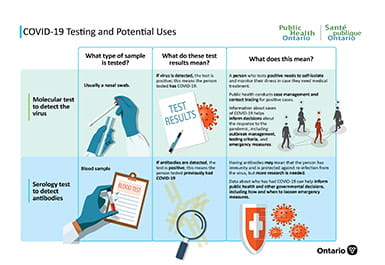
The Story of COVID-19 Testing in Ontario
COVID-19
26 May 2020
Since COVID-19 emerged in late 2019 and started to spread around the world, we’ve heard how important testing is, not just for those who may be infected, but also for understanding where and how the virus is spreading. This is important to plan effective public health responses and flatten the curve.
Testing methods and capacity in Ontario have ramped up quickly since the first case of COVID-19 was detected in January. They continue to advance as we learn more about the virus and spread of disease through the province. Ontario Health, PHO, and other key experts and stakeholders are collaborating to monitor, provide guidance, and strategize to make sure testing in the province continues to respond to this evolving public health emergency. In this post, we summarize some of the key developments and milestones in Ontario’s COVID-19 testing efforts.
Early Efforts
- January 10: Researchers in China sequenced the genetic code of COVID-19 and released it publicly.
- January 12: PHO developed the tools to be able to conduct testing for the virus and had performed the first test for COVID-19 in Ontario (which came back negative).
- January 27: With the help of the National Microbiology Laboratory in Winnipeg, PHO confirmed the first case of COVID-19 in Ontario.
Ramping Up
Through late January and early February, as the virus started to emerge in Ontario, mainly from returning travelers, PHO enhanced testing capacity – reducing the time required to test submitted samples for COVID-19, while also increasing the number of tests we could perform each day.
Some of these improvements were operational:
- PHO created a dedicated COVID-19 test request form for healthcare providers to make ordering the test and processing samples more efficient.
- PHO also began COVID-19 testing at several of our regional laboratory locations, and added additional shifts for testing to continue on nights and weekends, including 24/7 testing at our laboratory in Toronto.
- Following a survey of provincial lab capacity by the Ministry of Health in early March, many hospital and private labs were identified who were able to start conducting COVID-19 testing. PHO then played a significant role in helping these labs come online with testing and validating their initial tests to confirm their accuracy. The creation of this network of laboratories across the province has increased the number of tests that can be performed daily and has reduced wait times for test results.
Other COVID-19 testing advancements at PHO have been scientific and technical. For example, we developed the tools and transitioned from a testing method that requires many steps to be completed separately, to a much faster and more automated process. PHO has gotten new lab machinery that can run many more tests at once, contributing to the further increased lab capacity for the province and reducing turnaround time for samples that are submitted to PHO for testing.
Currently, most testing is conducted using polymerase chain reaction (PCR) to make copies of part of the genetic material in the sample and then check to see if the sample’s genetic material matches COVID-19. Find out more about testing methods and their applications.
Many countries across the world are also responding to COVID-19 and want to increase testing. In response to global supply challenges for materials needed for COVID-19 testing, PHO and our partners are engaged in ongoing work to evaluate and validate the use of different types of swabs, reagents (the chemicals use to conduct the PCR tests), and testing platforms so that our testing methods are flexible and can continue to meet the high-volume testing demands for the province and stay one step ahead of any upcoming supply challenges.
Moving Forward
Testing for COVID-19 continues to advance as the pandemic evolves. We, in collaboration with other labs, are continuing to look for faster methods of molecular testing to be able to further increase testing capacity. In addition, new testing technologies are being developed.
Unlike molecular testing, serology tests check for the presence of antibodies to COVID-19. Serology testing detects if an individual previously had COVID-19 and is a powerful tool to improve our understanding of and hone the public health response to COVID-19. Considerable research is still required to answer questions about the length of time that antibodies will persist and the extent and duration of immunity that the antibodies provide. Find out more about these two types of testing.
Another important laboratory tool is genomics, often described as genetic fingerprinting. Genomics can help understand pathways of transmission and infection and inform public health responses. PHO is collaborating with public health and academic partners, including the National Microbiology Laboratory, the Ontario Institute for Cancer Research, and the University of Toronto and McMaster University to apply genomics to the COVID-19 response.
Don’t have a MyPHO account? Register Now


